Serengeti National Park offers unparalleled opportunities for wildlife photography, showcasing diverse ecosystems and the iconic Great Migration. The cultural significance of the Maasai heritage enriches this experience, allowing for the capture of both wildlife and local traditions. Photographers face unique challenges in this dynamic environment while employing various techniques to highlight the stunning landscapes and vibrant Maasai culture. Understanding these elements enhances the overall photographic journey in the Serengeti.
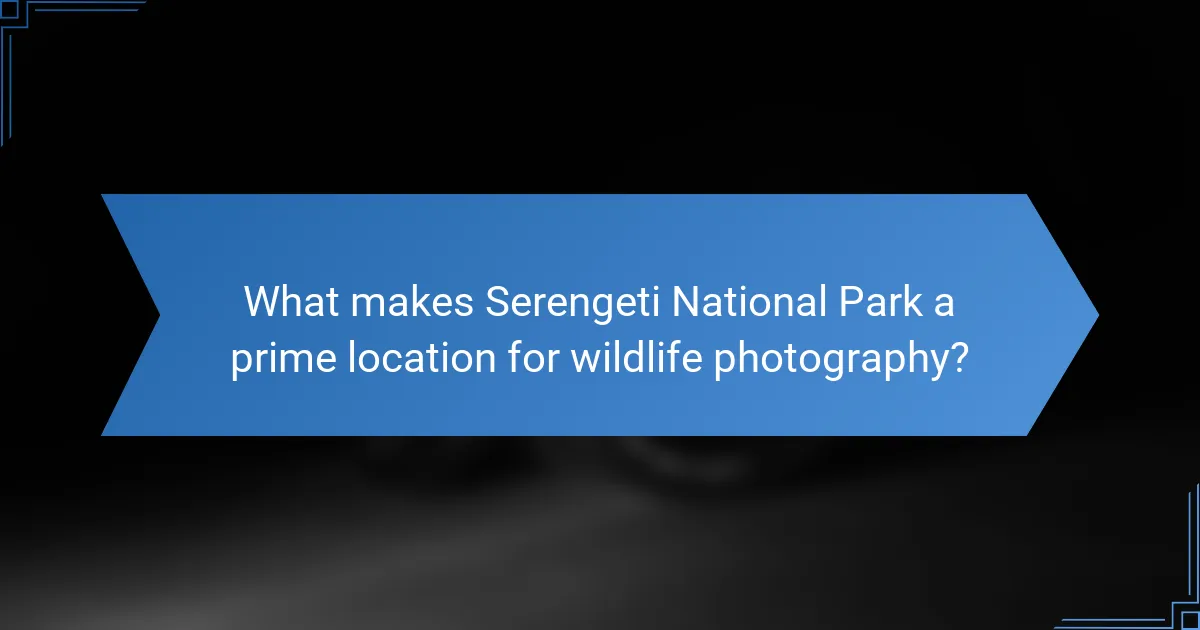
What makes Serengeti National Park a prime location for wildlife photography?
Serengeti National Park is a prime location for wildlife photography due to its diverse ecosystems and abundant animal species. The park hosts the Great Migration, where millions of wildebeest and zebras traverse the plains, providing unique photographic opportunities. The varied landscapes, from savannahs to woodlands, enhance the visual appeal of photographs. Additionally, the cultural significance of the Maasai heritage enriches the experience, allowing photographers to capture both wildlife and local traditions in one setting. The park’s accessibility and established tourism infrastructure further support wildlife photography endeavors.
Which species are most commonly photographed in the Serengeti?
The most commonly photographed species in the Serengeti include lions, elephants, cheetahs, zebras, and wildebeests. These animals attract photographers due to their iconic presence and dynamic behaviors. Lions are often captured during hunts, while elephants are photographed in herds. Cheetahs showcase their speed, and zebras and wildebeests are popular during the Great Migration. This diversity enhances the cultural significance of Maasai heritage through wildlife interactions.
How does the park’s ecosystem support diverse wildlife?
The park’s ecosystem supports diverse wildlife through its varied habitats, abundant food sources, and water availability. Serengeti National Park features grasslands, woodlands, and wetlands, creating niches for different species. This diversity fosters a balanced food web, essential for predator-prey dynamics. The migration of wildebeest and zebras also enhances ecological interactions, providing sustenance for carnivores. Furthermore, the Maasai heritage promotes conservation practices that protect wildlife habitats, ensuring long-term ecosystem stability.
What are the best times of year for wildlife photography in the Serengeti?
The best times for wildlife photography in the Serengeti are during the Great Migration from June to October and the calving season in January and February. These periods offer optimal wildlife visibility and dynamic scenes.
During the Great Migration, herds of wildebeest and zebras traverse the plains, providing dramatic photographic opportunities. In contrast, the calving season showcases newborn animals, enhancing the emotional appeal of wildlife images.
Other good times include the rainy seasons, which attract various bird species and transform landscapes, creating vibrant backdrops. Each season offers unique attributes, enriching the photography experience in this iconic national park.
How do weather conditions influence photography opportunities in the park?
Weather conditions significantly influence photography opportunities in Serengeti National Park. Overcast skies often provide soft, diffused light ideal for capturing wildlife. Conversely, clear skies can enhance vibrant colors during sunrise and sunset, creating dramatic landscapes. Rainy seasons offer unique chances to photograph animals interacting with water sources. Additionally, seasonal migrations attract diverse wildlife, presenting exceptional moments for photographers. Understanding these weather patterns aids in planning optimal photography sessions.
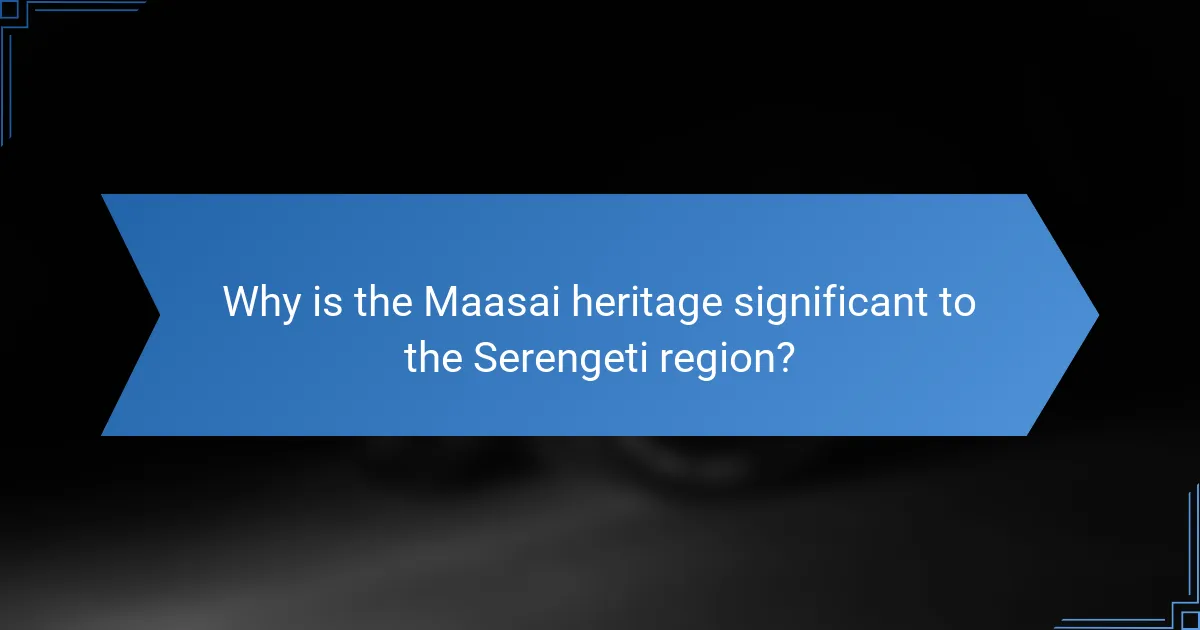
Why is the Maasai heritage significant to the Serengeti region?
The Maasai heritage is significant to the Serengeti region because it embodies the cultural identity and traditional practices of the Maasai people, who coexist with the wildlife. Their unique attributes, such as vibrant dress and intricate beadwork, enhance the region’s cultural landscape. The Maasai’s sustainable pastoralist lifestyle contributes to the conservation of the Serengeti’s ecosystem. This relationship between culture and nature attracts wildlife photographers, fostering appreciation for both the landscape and its indigenous people. The Maasai’s role in tourism promotes awareness and respect for their heritage while supporting local economies.
What cultural practices are unique to the Maasai people?
The Maasai people have unique cultural practices that include traditional ceremonies, distinctive clothing, and communal living. Their rites of passage, such as circumcision and warrior initiation, are significant cultural milestones. The Maasai are known for their vibrant shúkà, a red-checked garment symbolizing bravery and strength. Additionally, they practice a semi-nomadic lifestyle, herding cattle and relying on their livestock for sustenance. These practices reinforce their deep connection to the land and their heritage, making them an integral part of the Serengeti’s cultural landscape.
How do Maasai traditions influence wildlife conservation efforts?
Maasai traditions significantly enhance wildlife conservation efforts by fostering a deep respect for nature. Their cultural practices promote sustainable land use, ensuring wildlife habitats are preserved. The Maasai community actively participates in conservation initiatives, leveraging their traditional knowledge to protect endangered species. Their unique relationship with the land encourages eco-tourism, providing economic benefits while safeguarding biodiversity.
What role do Maasai communities play in tourism within the Serengeti?
Maasai communities significantly enhance tourism in the Serengeti through cultural interactions and authentic experiences. Their traditional practices, such as dance and storytelling, attract visitors seeking deeper connections to the region. Additionally, the Maasai’s knowledge of wildlife and conservation contributes to sustainable tourism initiatives. This unique attribute fosters a symbiotic relationship between cultural heritage and wildlife preservation, enriching the overall visitor experience in Serengeti National Park.
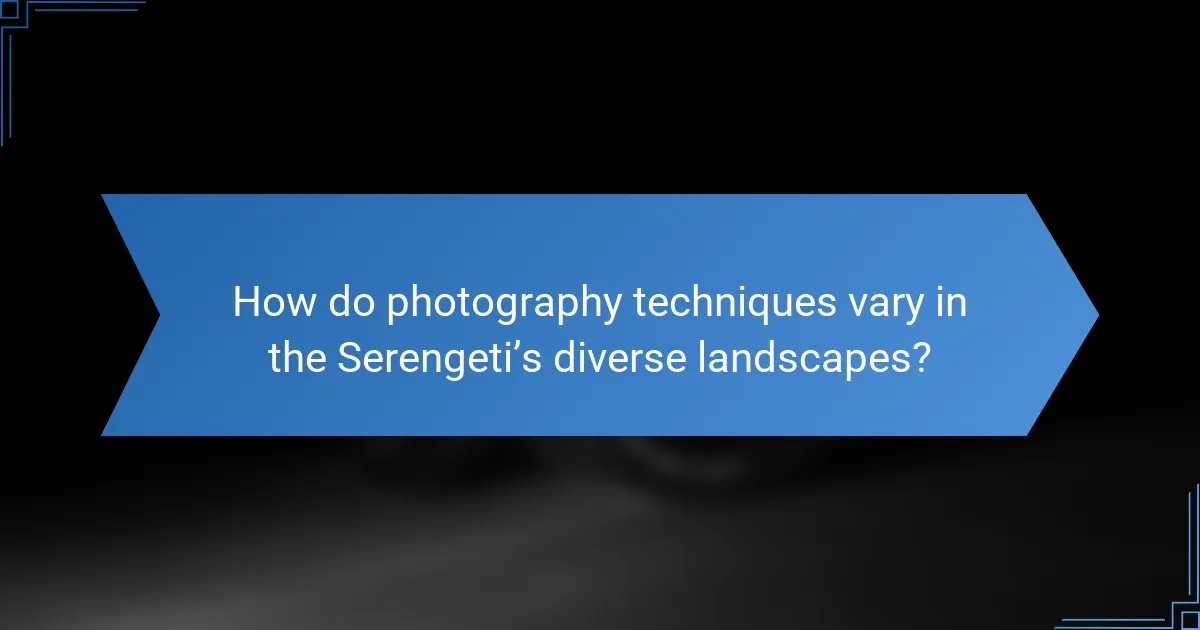
How do photography techniques vary in the Serengeti’s diverse landscapes?
Photography techniques in the Serengeti vary significantly due to its diverse landscapes. Different environments, such as savannahs, wetlands, and woodlands, require unique approaches to capture wildlife effectively. For instance, wide-angle lenses are ideal for expansive savannah scenes, while telephoto lenses excel in capturing distant animals. Lighting conditions also differ; golden hour offers soft light in open areas, while shaded forest regions may necessitate higher ISO settings. Understanding these variations enhances the ability to portray both wildlife and the cultural significance of the Maasai heritage within the Serengeti’s backdrop.
What equipment is recommended for capturing wildlife in the Serengeti?
A recommended setup for capturing wildlife in the Serengeti includes a DSLR or mirrorless camera with a telephoto lens. A lens with a focal length of 300mm to 600mm allows for close-up shots of animals without disturbing them. A sturdy tripod or monopod stabilizes the camera for clearer images. Additionally, a good quality zoom lens offers versatility for varying distances. Consider using a fast memory card to handle high-speed shooting. Lastly, protective gear for both the camera and yourself is essential to withstand the park’s conditions.
How can photographers adapt to different lighting conditions in the park?
Photographers can adapt to varying lighting conditions in Serengeti National Park by utilizing specific techniques. They should adjust their camera settings, such as ISO and aperture, to capture the best images.
In bright daylight, using a fast shutter speed helps freeze motion, while in low light, a slower shutter speed can enhance exposure. Photographers can also leverage the golden hour, shortly after sunrise or before sunset, to achieve softer, more flattering light.
Using reflectors or diffusers can help manage harsh shadows and highlights. Additionally, understanding the behavior of wildlife during different times of day allows photographers to anticipate lighting changes and position themselves effectively.
What composition tips are essential for stunning wildlife shots?
To achieve stunning wildlife shots in Serengeti National Park, focus on composition techniques that highlight both the animals and the cultural significance of the Maasai heritage. Use the rule of thirds to create balanced images, framing subjects against the vast landscapes. Capture the golden hours of sunrise and sunset for optimal lighting, enhancing colors and shadows. Incorporate local Maasai elements, such as traditional attire or structures, to add depth and context to wildlife scenes. Experiment with different angles and perspectives to showcase the dynamic interactions between animals and their environment.
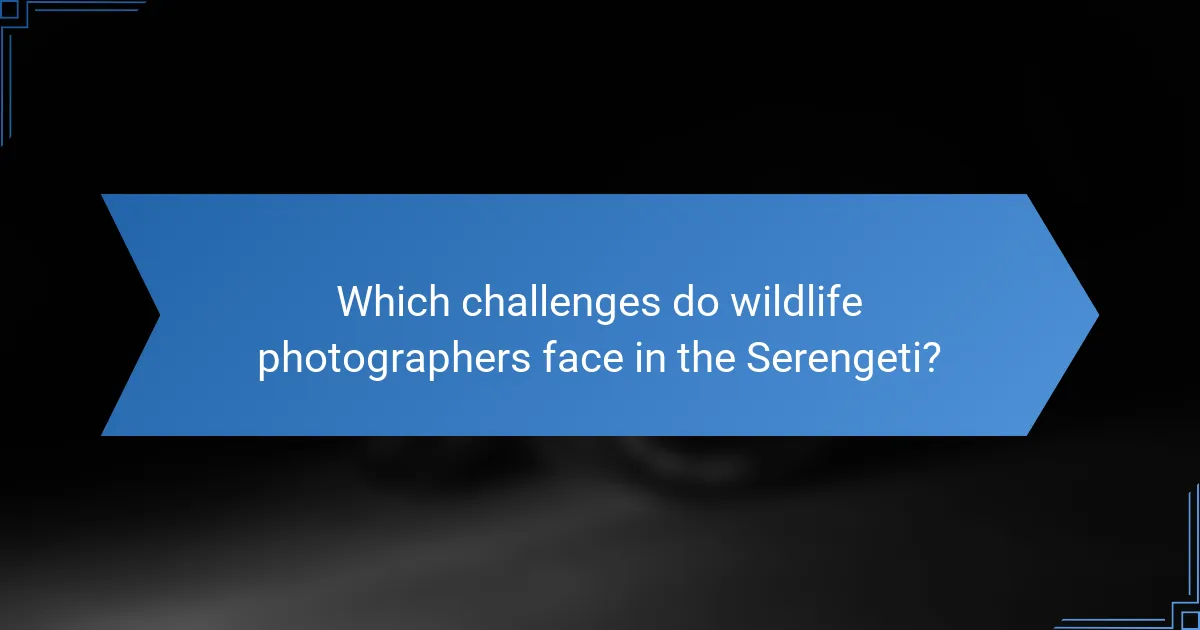
Which challenges do wildlife photographers face in the Serengeti?
Wildlife photographers in the Serengeti face numerous challenges. These include unpredictable weather conditions, limited access to wildlife, and the need for patience and timing. Additionally, photographers must navigate rough terrain and potential safety risks from wildlife encounters. The cultural significance of Maasai heritage adds complexity, as photographers must respect local customs while capturing images.
How can photographers ensure ethical interactions with wildlife?
Photographers can ensure ethical interactions with wildlife by following guidelines that respect both animals and local cultures. Prioritize minimal disturbance to wildlife, maintaining a safe distance and avoiding stressful situations.
Engage with Maasai communities to understand their cultural significance and perspectives on wildlife. Collaborate with local guides to enhance respect for both the environment and cultural heritage. Follow regulations set by Serengeti National Park to support conservation efforts.
Educate yourself on animal behavior to predict reactions and avoid negative impacts. Lastly, promote ethical practices through sharing experiences and advocating for responsible wildlife photography.
What are common technical difficulties faced during wildlife shoots?
Common technical difficulties during wildlife shoots include unpredictable weather, challenging lighting conditions, and equipment malfunctions. These factors can hinder capturing high-quality images of the diverse fauna in Serengeti National Park. Additionally, the movement of animals may complicate framing and focus. Limited access to certain areas can restrict opportunities for close-up shots, impacting the overall photographic experience.
How does the presence of other tourists impact wildlife photography?
The presence of other tourists can disrupt wildlife photography by causing animals to alter their behavior. Increased noise and movement from tourists may lead to wildlife avoiding areas frequented by people, impacting the chances of capturing natural moments. Furthermore, crowded locations can limit photographers’ access to optimal vantage points, reducing the quality of images taken. In the Serengeti National Park, the balance between tourism and wildlife conservation is crucial for maintaining both the cultural significance of Maasai heritage and the integrity of wildlife photography.
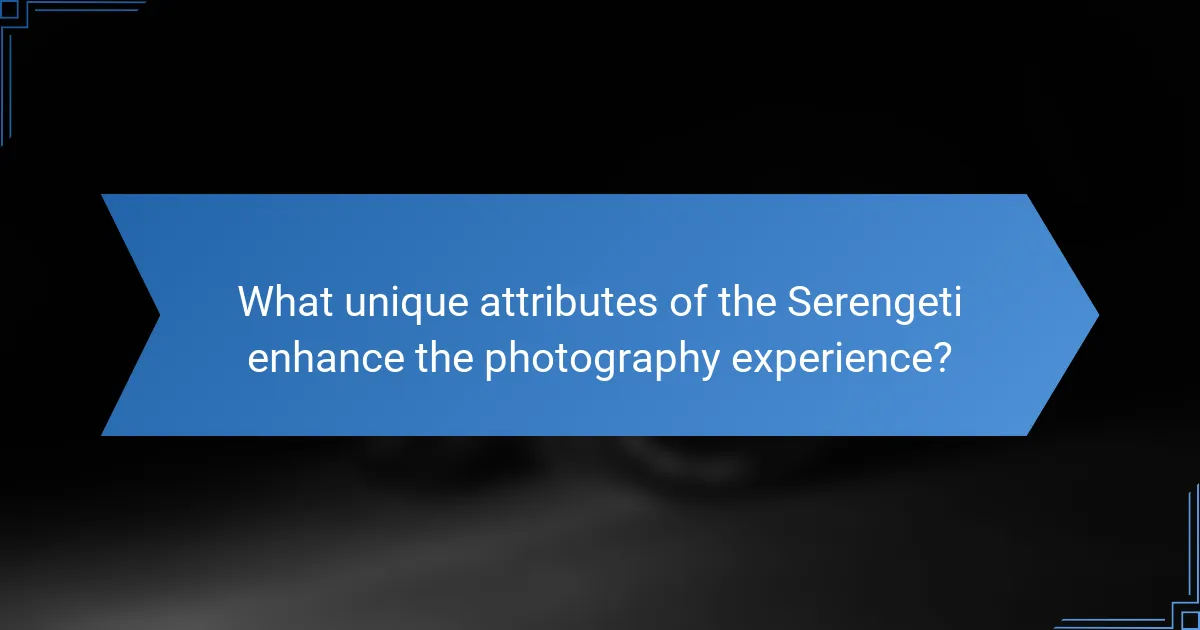
What unique attributes of the Serengeti enhance the photography experience?
The unique attributes of the Serengeti enhance the photography experience through diverse wildlife, stunning landscapes, and vibrant cultural elements. The park hosts the Great Migration, featuring millions of wildebeest and zebras, offering dynamic action shots. Iconic vistas, such as the Ngorongoro Crater and vast savannahs, create breathtaking backdrops. Additionally, interactions with the Maasai people provide rich cultural contexts, enriching the visual storytelling of photography. These factors collectively elevate the photographic opportunities in the Serengeti.
How do migratory patterns affect photographic opportunities?
Migratory patterns significantly enhance photographic opportunities in Serengeti National Park. The annual wildebeest migration creates dynamic scenes, attracting photographers seeking to capture the movement and drama of wildlife. This event typically occurs between June and September, offering optimal conditions for stunning imagery. The diversity of animals and their interactions during migration provide unique opportunities to document both wildlife behavior and the cultural significance of the Maasai heritage intertwined with the landscape. Photographers can also explore various vantage points, maximizing their chances of capturing breathtaking moments.
What rare wildlife sightings can photographers expect in the Serengeti?
Photographers can expect rare wildlife sightings such as the Ethiopian wolf, African wild dog, and the shoebill stork in the Serengeti. These species are elusive and often difficult to capture on camera due to their limited populations and specific habitats. The Ethiopian wolf, for instance, is critically endangered, with only about 250 individuals remaining in the wild. African wild dogs are known for their unique pack hunting behavior, making them a fascinating subject for wildlife photography. The shoebill stork, with its distinctive bill, is a rare sight that captivates photographers seeking unique images. Each of these species adds significant value to the cultural and ecological tapestry of the Serengeti.
How does the interplay of light and landscape create unique photographic moments?
The interplay of light and landscape in Serengeti National Park creates unique photographic moments by enhancing wildlife visibility and cultural richness. The golden hour, when sunlight is soft and warm, accentuates the vibrant hues of the landscape and the animals. This natural lighting highlights the Maasai heritage, showcasing their traditional attire against the backdrop of expansive savannas. Shadows and contrasts formed by the terrain add depth to images, capturing the essence of both wildlife and cultural significance. Photographers can leverage these elements to tell compelling stories through their work, making each shot a unique moment in time.
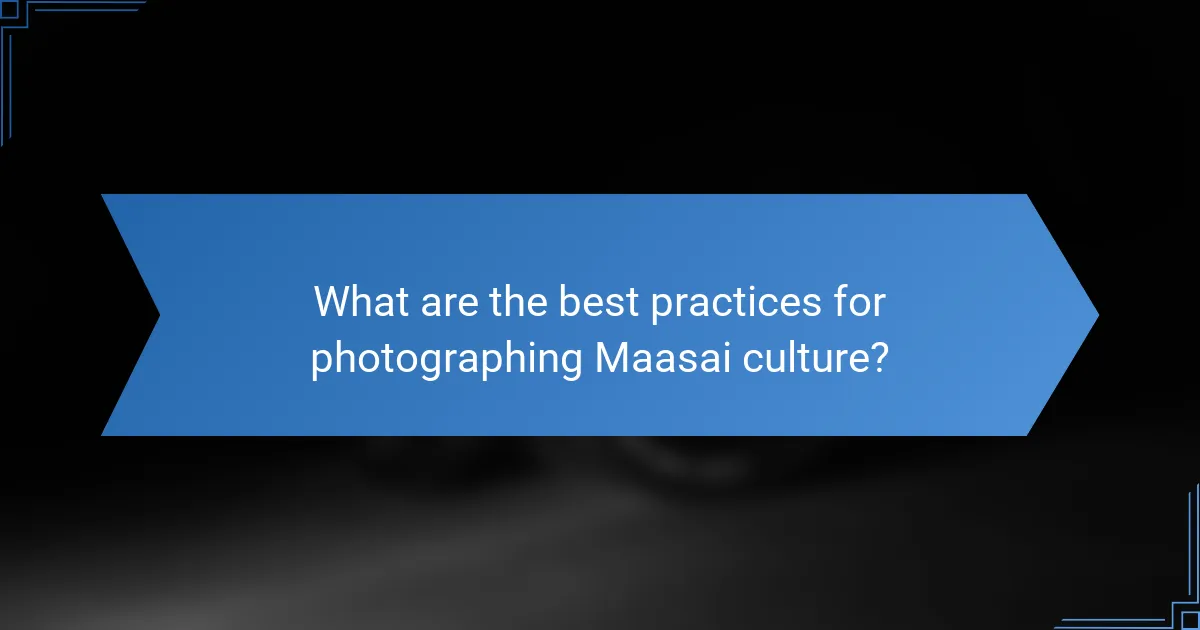
What are the best practices for photographing Maasai culture?
To photograph Maasai culture effectively, focus on respectful engagement and capturing authentic moments. Prioritize natural light and candid interactions to showcase the vibrancy of their traditions.
Consider these best practices:
1. Build rapport with the community to gain trust.
2. Use a wide-angle lens to capture both people and landscapes.
3. Document cultural events and ceremonies for dynamic storytelling.
4. Be mindful of cultural sensitivities regarding photography.
5. Experiment with composition to highlight traditional attire and craftsmanship.
These approaches enhance the cultural significance of Maasai heritage while promoting wildlife photography in Serengeti National Park.
How can photographers respectfully capture Maasai traditions?
Photographers can respectfully capture Maasai traditions by prioritizing consent, understanding cultural significance, and showcasing authentic practices. Engaging with the community fosters trust and encourages genuine representation.
Research the Maasai culture to avoid misrepresentation and to highlight their values. Use natural settings in Serengeti National Park to depict traditional lifestyles alongside wildlife.
Consider collaborating with Maasai guides to gain insights and access to culturally significant events. This partnership enhances storytelling and ensures respectful portrayal.
Lastly, share the outcomes with the community, allowing them to benefit from the exposure while preserving their dignity and heritage.
What are the ethical considerations when photographing indigenous people?
Ethical considerations when photographing indigenous people include obtaining informed consent, respecting cultural practices, and avoiding exploitation. Photographers must recognize the Maasai’s unique heritage while ensuring their portrayal aligns with their values. Sensitivity to cultural significance fosters respectful representation in wildlife photography.
How can photographers promote cultural awareness through their work?
Photographers can promote cultural awareness by showcasing the wildlife and heritage of the Maasai in Serengeti National Park. Their work highlights the interconnectedness of nature and cultural identity, fostering appreciation for both.
Capturing images of Maasai people in traditional attire amidst the park’s wildlife emphasizes their role as stewards of the land. This representation encourages dialogue about conservation and cultural preservation.
Additionally, photographers can collaborate with local Maasai communities to tell authentic stories, ensuring that their perspectives and experiences are accurately portrayed. This collaboration enhances cultural understanding and respect.
Through exhibitions, social media campaigns, and educational workshops, photographers can amplify Maasai voices, creating a platform for cultural exchange and awareness.
What common mistakes should photographers avoid when documenting Maasai heritage?
Photographers should avoid common mistakes such as cultural insensitivity, inadequate research, and poor composition when documenting Maasai heritage. Understanding the Maasai’s traditions and values is crucial for respectful representation. Failing to engage with the community can lead to misinterpretations of their lifestyle. Additionally, neglecting the unique landscapes of Serengeti National Park can diminish the cultural context in wildlife photography. Lastly, overlooking lighting and timing can result in missed opportunities for capturing the vibrancy of Maasai culture.